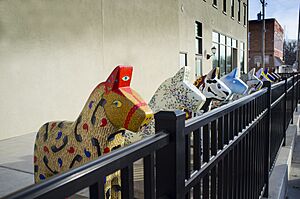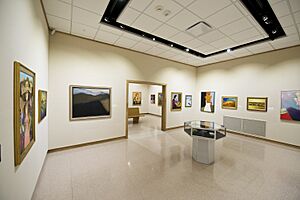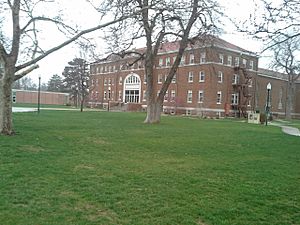Lindsborg, Kansas facts for kids
Quick facts for kids
Lindsborg, Kansas
|
|
|---|---|
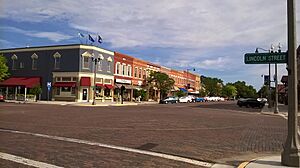
Intersection of Lincoln and Main Streets (2016)
|
|
| Nickname(s):
Little Sweden
|
|
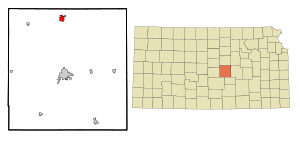
Location within McPherson County and Kansas
|
|
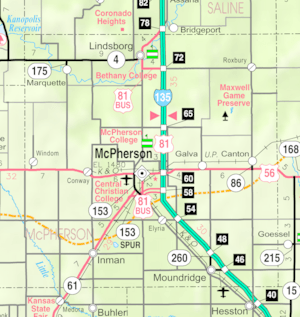
|
|
| Country | United States |
| State | Kansas |
| County | McPherson |
| Founded | 1869 |
| Incorporated | 1879 |
| Named for | Linden Castle |
| Area | |
| • Total | 1.85 sq mi (4.78 km2) |
| • Land | 1.83 sq mi (4.74 km2) |
| • Water | 0.02 sq mi (0.04 km2) |
| Elevation | 1,332 ft (406 m) |
| Population
(2020)
|
|
| • Total | 3,776 |
| • Density | 2,041/sq mi (790.0/km2) |
| Time zone | UTC-6 (CST) |
| • Summer (DST) | UTC-5 (CDT) |
| ZIP code |
67456
|
| Area code | 785 |
| FIPS code | 20-41375 |
| GNIS ID | 485614 |
Lindsborg is a city in McPherson County, Kansas, United States. In 2020, about 3,776 people lived there. Lindsborg is famous for its strong Swedish and other Scandinavian roots. It hosts a special festival every two years called the Svensk Hyllningsfest.
Contents
History of Lindsborg
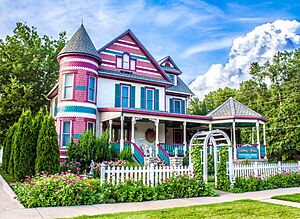
For thousands of years, the Great Plains of North America were home to traveling Native American tribes. Later, in the 16th to 18th centuries, France claimed much of this land. In 1803, the United States bought a huge area, including what is now Kansas, from France. This was part of the Louisiana Purchase.
In 1861, Kansas became the 34th U.S. state. Lindsborg was settled in the spring of 1869. A group of immigrants from Sweden came here, led by Pastor Olof Olsson. In 1879, Lindsborg officially became a city, and the first railroad arrived that same year.
The name Lindsborg means Linden Castle in Swedish. It refers to a type of tree. The town was named after four men with "Lind" in their last names. They were part of a Swedish farming group that helped settle Lindsborg.
Today, about 30% of the people living in Lindsborg have Swedish family roots. Because the town has kept so much of its founders' culture, it's known as "Little Sweden." Downtown shops sell Swedish gifts, like different sizes of Dala horses. Lindsborg is also famous for the Svensk Hyllningsfest, a big celebration held every two years since 1941.
Lindsborg is home to the Swedish Pavilion. This building was first built for the 1904 St. Louis World's Fair. After the fair, it was given to Bethany College in Lindsborg. It was later moved to the Lindsborg Old Mill & Swedish Heritage Museum in 1969.
The Birger Sandzén Memorial Gallery is also in Lindsborg. It opened in 1957 on the Bethany College campus. This gallery shows the amazing artwork of Birger Sandzén, an artist who lived in the city. It has the largest collection of his paintings and drawings in the world.
In April 1976, Swedish King Carl XVI Gustaf visited Lindsborg during his trip to the United States. In 2004, the United States Chess Federation named Lindsborg the "Chess City of the Year."
Geography and Climate
Lindsborg covers about 1.69 square miles (4.38 square kilometers). Most of this area is land, with a small amount of water.
Local Climate
The weather in Lindsborg has hot and humid summers. Winters are usually mild to cool. This type of weather is known as a humid subtropical climate.
Population of Lindsborg
| Historical population | |||
|---|---|---|---|
| Census | Pop. | %± | |
| 1880 | 466 | — | |
| 1890 | 968 | 107.7% | |
| 1900 | 1,279 | 32.1% | |
| 1910 | 1,939 | 51.6% | |
| 1920 | 1,897 | −2.2% | |
| 1930 | 2,016 | 6.3% | |
| 1940 | 1,913 | −5.1% | |
| 1950 | 2,383 | 24.6% | |
| 1960 | 2,609 | 9.5% | |
| 1970 | 2,764 | 5.9% | |
| 1980 | 3,155 | 14.1% | |
| 1990 | 3,076 | −2.5% | |
| 2000 | 3,321 | 8.0% | |
| 2010 | 3,458 | 4.1% | |
| 2020 | 3,776 | 9.2% | |
| U.S. Decennial Census | |||
In 2020, Lindsborg had 3,776 people living in it. The city has grown steadily over the years. Many different groups of people make up the community.
Arts and Culture
Fun Events in Lindsborg
- Chocolate Lovers Affair & Art Auction: This event happens every February. It helps support local arts and art students.
- Våffeldagen (Waffle Day): Celebrated every March.
- Messiah Festival of the Arts: A big arts festival that ends with a performance of Handel's Messiah. It has been happening since 1881.
- Lindsborg City-Wide Garage Sale: An annual yard sale in May for everyone.
- Millfest: This festival takes place on the first Saturday in May. It features historic sites, American folk music, woodcarving, and old-fashioned games.
- Midsummer: An annual summer festival celebrating the longest day of the year.
- Smoky Valley Classic Car Show: A show for cool old cars.
- Lindsborg Street Dance: A summer evening dance party with live music.
- Coronado Heights Run: An October event with a kids' fun walk, a 5K, and a 15K run on country roads.
- The Falun Classic Bike Ride: A 32-mile bicycle ride in October.
- Svensk Hyllningsfest: A special tribute to the Swedish pioneers. It happens every two years in October.
- Christmas in Lindsborg: A month of holiday events in December. These include the Snowflake Parade, a St. Lucia Festival, and Annandag Jul.
Places to Visit
- Birger Sandzén Memorial Gallery: See amazing art, especially by Birger Sandzén.
- Red Barn Studio Museum: A unique art space.
- Clara Hatton Center: An art museum and event space.
- Smoky Valley Arts and Folk Life Center: Learn about local arts and traditions.
- Coronado Heights: A historic spot with great views.
- Smoky Valley Roller Mill: A historic mill to explore.
- Broadway RFD: Kansas's longest-running outdoor theater, started in 1959.
- International Chess Institute of the Midwest: A place to learn and play chess.
- Swedish Pavilion: A historic building from the 1904 World's Fair.
- Historic Homes Tour: See beautiful old houses in the city.
Education
Lindsborg has its own public school district, Smoky Valley USD 400.
Schools in Lindsborg
- Smoky Valley High School
- Smoky Valley Middle School
- Soderstrom Elementary
College
- Bethany College is located here.
Other Learning Centers
- The International Chess School of the Midwest, also known as the Anatoly Karpov International School of Chess, is downtown.
Transportation
The K-4 highway goes through Lindsborg. You can also find bus service daily to nearby cities like Wichita and Salina.
Notable People
- Jay Emler: A former leader in the Kansas Senate.
- Ted Kessinger: A retired college football coach, who is in the College Football Hall of Fame.
- Ebba Nylander: A violinist and conductor born in Lindsborg.
- John W. Peterson: A Gospel songwriter from Lindsborg.
- Birger Sandzén: A Swedish-born painter and teacher whose art is famous.
Gallery
-
Swedish Pavilion from 1904 Saint Louis World's Fair, 2009
See also
 In Spanish: Lindsborg para niños
In Spanish: Lindsborg para niños


